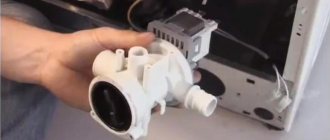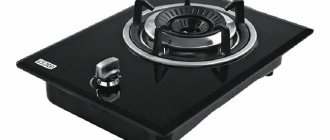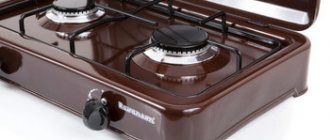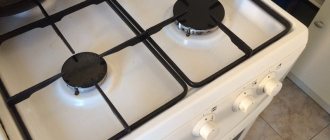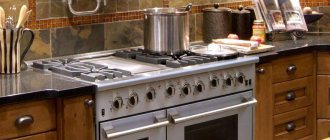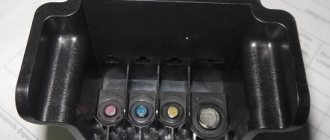Despite the diversity of cookers, the introduction of various new functions and materials, their main task is cooking. Moreover, the operation of such equipment is carried out either by gas or electricity. In this article we will talk about gas units and jets for a gas stove, as well as situations when they may need to be replaced.
Purpose and types of jets
The purpose of a gas stove nozzle is to ensure gas flow to the burner. At the same time, it also evens out the flame on the burner due to the dosed supply of combustible substances. You can connect the kitchen stove to gas coming from a gas pipeline or liquefied gas in cylinders. Since such substances have different pressures and compositions, different jets will be required. Their main difference is the different hole diameter. LPG requires a narrower diameter. Also, the greater the power of the burner, the larger the hole size will be.
It happens that, after serving for some time in the kitchen in an apartment, an outdated stove is transported to a dacha or to a country house where there is no main gas pipeline or connection to it. And gas in cylinders will be used as a flammable substance. In such a situation, you not only need to connect the cylinder correctly, but also replace all the nozzles.
Types and characteristics
@Doski.ru
There are two types of jets - for stoves connected to a gas pipeline and for stoves running on liquefied gas.
The nozzle has a hexagonal head and a base with external thread. The head is marked. The numbers indicate how many cubic centimeters of fuel the part passes per minute.
Since the gas in the cylinders is under high pressure, nozzles with large holes are used for such cases. If you do not replace them, the gas will flow to the burner in larger quantities and will not be able to burn completely. In this case, black carbon deposits will form on the dishes, and a mixture of gases harmful to humans may accumulate in the kitchen.
The pressure in the main system is much lower. To ensure high-quality combustion, nozzles with small holes are used for such stoves, which, on the contrary, increase the pressure.
How to replace jets yourself
As a rule, injectors rarely fail, and many people do not even suspect that they can be replaced at home. One of the cases where it is necessary to change injectors is when changing the type of fuel, as mentioned above. But the need to replace jets on a gas stove also appears in the following cases:
- the color of the flame has changed: yellow and red inclusions appear instead of the usual blue color;
- there is soot or uneven combustion;
- there is a hissing sound, and at the same time the flame separates from the burner or goes out;
- When the burner is ignited, a popping sound is heard.
If you are going to fix the problem yourself, then we will consider the whole process step by step.
Disassembling the burner
Our service center offers its services for repairing household appliances at a competitive price. We repair any breakdowns of modern household appliances. Leave a request and get a 15% discount - Leave a request
First, of course, you need to shut off the gas supply. In general, working with gas equipment requires special care and compliance with safety precautions. After this, remove the grate from the cooking surface. The burners themselves can be removed without effort. To replace the jets, in some models of gas units you will need to unscrew the top panel of the hob. But more often the nozzle is visible right under the burner.
If you have an older model of equipment, and the jet is located in the housing, you will have to disassemble it. In this case, you need to unscrew the bolts at the corners of the hob. There may be other assembly options where the panel will have to be pryed off to separate it from the main body. In this case, of course, it is better to look in the documentation where exactly the required elements are located and how to get to them.
The internal structure may look like this. A pair of parallel metal strips is a traverse, onto which the burner bodies are attached. The gas supply to the burner is similar for all units. The burner body contains the nozzle itself, to which the gas pipeline is connected. Through the tip, the fuel is supplied to the nozzle, from where the gas flows to the burner.
Unscrew the jet
To unscrew the jets in a gas stove, you will need an open-end wrench or a tubular wrench, depending on the model. It should be said that in older models of such equipment, getting to the nozzle can be extremely difficult, since it is located in the burner body and it will not be easy to unscrew it with a key. It may be necessary to disassemble almost the entire unit. In this case, it is better to remember the sequence of actions and prepare different small containers for the parts that you will remove.
For more modern models, the process should not cause difficulties. When replacing, you need to take into account the size and thread of the nozzle. Some kitchen appliances are equipped with nozzles for converting to liquefied gas, and all replacement steps are clearly stated in the instructions, for example, in the Darin 1A GM 441 002W model. If the kit does not include such parts, it is better to seek advice from the seller of a specialized store. In this case, it is advisable to have with you old nozzles or at least measurements of the diameter and thread pitch.
Checking the channel
If your goal was not to change the nozzles to use a different fuel, but only to eliminate the combustion problem, then it is quite possible that the hole was simply clogged. And cleaning it will save you from replacing it. You can do this with any thin sharp object, such as an awl or a knitting needle. It is important that the diameter of the object is not wider than the diameter of the hole. Otherwise, you can deform it, which is unacceptable. For the same reason, cleaning must be done with caution.
Replacing the jet
As already noted, in modern models it is not difficult to get to the injector and replace it. In a more complex situation, it is located in the burner body. And to change it, you will have to remove the tip with the nozzle from the burner body. To do this, you will need to remove the latch, which is located directly under the body and looks like a clothespin. It is worth remembering that when performing such actions you should not make too much effort so as not to break individual parts.
It is not recommended to unscrew the nozzle directly from the body, as this may deform it or damage other parts.
Assembling the burner
After replacing all the nozzles, you will need to reassemble the burner in the reverse order. After this, you can switch from natural gas to bottled gas. But before that, you need to remember to change the nozzle in the oven.
Burner is ready
After the burner is assembled, it is too early to start checking the flame of the fire. Below we will look at replacing oven jets in a gas stove with our own hands.
How to convert a gas stove to bottled or natural gas
Natural gas, usually NG G20, is supplied to the kitchen from the central gas supply system, which is supplied to the device at a pressure of 20 mbar. Liquefied gas is used for cylinders, the most common is LPG G30. It enters the device at a pressure of 50 mbar. The combustion of gas-air mixtures is not the same due to differences in composition and pressure. To level the flame and prevent the appearance of soot, jets of certain sizes are installed in the burners.
The jet (nozzle or nozzle) is usually made of bronze or brass. It looks like a threaded bolt, but only has an internal hole through which fuel is supplied. The larger it is, the more gas flows through it. At the end of the nozzle there are numbers stamped out that indicate the diameter of the hole in hundredths of a millimeter. For example, the number 75 means the hole diameter is 0.75 mm, and the number 115 means the diameter is 1.15 mm.
The size of the hole depends on the type of gas and the power of the burner. Since the pressure of liquefied and natural gas is not the same, different sets of nozzles have been developed for them. For bottled gas, nozzles with a smaller diameter are used, since its pressure is higher than that of natural gas.
Each burner (small, medium, large, oven) has its own jet, which corresponds to a number determined by the manufacturer. The smaller the burner, the lower its power. For its operation, less gas-air mixture is needed, which means that the diameter of the hole should be small.
Reference. Jets from different manufacturers may differ in shape, configuration and external thread diameter.
Nozzles are replaced if it is necessary to convert a gas stove from natural gas to liquefied gas and vice versa. But this is not the only reason. Jets are changed if:
- the fuel burns unevenly and the stove smokes during operation;
- the flame hisses and comes off the burner;
- the color of the flame is not blue, but yellow-white with red highlights.
These signs indicate that the gas stove has unsuitable nozzles. When the equipment does not work correctly, it is recommended to replace not just one injector, but the entire set. When switching to bottled gas, this is even necessary.
The differences between nozzles for natural fuel and nozzles for cylinders are as follows:
- shortened bolt body;
- fewer threads;
- increased hole diameter.
Manufacturers usually supply household appliances with two types of nozzles. But if they are not there or the device was purchased a long time ago, the jets can be purchased in the store or ordered on the manufacturer’s website.
Before purchasing, you need to determine what hole diameter is needed. It is important to approach the choice of nozzles for bottled or natural gas responsibly, since the safety of users depends on it. When the gas from the nozzle flows crookedly, some of it accumulates under the hob. This may cause an explosion. The technical data sheet for household appliances contains data on jets for central gas supply and cylinder. If it has been lost, you can find it on the Internet by indicating the brand of the device.
It is not recommended to change the dimensions of the jet holes yourself (try to drill them out or reduce them). Is it dangerous.
The ratio of hole diameters (in mm) to different types of fuel is given in the table.
| Burner type | Gas type (pressure) | |||
| NG G20 (20 mbar) | LPG G30 (50 mbar) | NG G25 (20 mbar) | LPG G30 (30 mbar) | |
| Small burner | 0,75 | 0,43 | 0,70 | 0,50 |
| Middle burner | 0,92 | 0,55 | 0,92 | 0,65 |
| Large burner | 1,15 | 0,60 | 1,15 | 0,75 |
| Oven burner | 1,20 | 0,65 | 1,15 | 0,75 |
| Grill burner | 0,95 | 0,60 | 0,95 | 0,65 |
When converting the stove to liquefied gas, it should be taken into account that not only the nozzles are changed, but also a reducer is installed. It is used to regulate the pressure of incoming fuel.
Replacing nozzles in a gas stove
Before replacing the nozzle, be sure to study the technical data sheet of your kitchen unit. The parameters for liquefied gas and the main gas pipeline are indicated there. Even for one stove, different jets may be needed, since the power of the burners may be different. All injectors must be marked. You can purchase them in markets, gas equipment stores or online resources.
Stove burners
When you plan to convert the stove to bottled propane, you will need to replace not only the burner nozzles, but also install a reducer. This is a special adapter that will regulate the gas supply from the cylinder and stabilize the pressure in the system. It is placed directly on the cylinder itself.
Oven nozzle
Replacing the nozzle for liquefied gas in an oven will be similar to replacing those in the burners of a gas stove. It is important to find the location of the nozzle itself. Depending on the model, you need to remove either the front bottom panel, which is located below the oven, or unscrew the panel inside the oven. Then you will have to remove the burner. And the component we need will be located on the inner wall of the oven. Again, the jet is located in the housing and can become stuck to it over time. Therefore, to remove it, you may need to unscrew the body itself, and then treat the threads with kerosene or other means that will help remove the nozzle.
Symptoms of incorrect selection of gas injectors
Incorrect operation of the gas stove burners can be judged by the following signs:
- A balanced burner ignites without popping, does not go out, burns evenly and without buzzing.
- With an optimal ratio in the mixture of gas and air, the fire acquires a blue color with a greenish tint.
- With too much air, the flame becomes low and burns with a hiss. In this situation, it is also possible for the flame to come off the burner and go out.
- A milky-yellow fire with soot indicates insufficient oxygen supply and incomplete combustion of gas.
The information discussed about jets for gas stoves is advisory in nature. It is very important to understand that the use of gas for domestic purposes does not forgive neglect. If you have the slightest suspicion of unstable operation, do not engage in amateur activities and immediately consult with specialists.
Connection and setup
After installing nozzles for liquefied gas, which differ from those for natural gas, you can begin connecting the cylinder itself.
Before opening the valve on the cylinder, you must install a reducer on it.
You can install the cylinder indoors with a stove, but it is recommended to take it out to a shady place outside, in a metal box adapted for this purpose. In this case, the distance from the window should be at least 0.5 meters. It is always better to turn off the tap after cooking.
Connection to the cylinder
The connection to bottled gas is similar for all similar equipment, for example, the Hephaestus stove. The reducer is screwed onto the cylinder. A gasket must be installed. A fitting is screwed onto the inlet pipe of the plate. It can be included with the unit. A gasket is also needed here. Now a gas hose is connected to the outlet of the reducer and connected to the fitting on the stove. The hose is secured with clamps. If the hose is inserted from the street through a hole in the wall, be sure to place a piece of metal pipe in the hole to avoid chafing of the hose.
The following requirements apply to the hose:
- should be no longer than one and a half meters;
- it is advisable to carefully secure it to ensure its immobility as much as possible;
- it should not break or bend;
- it must be a special hose designed for such gas;
- do not use beyond the prescribed service life;
- Be sure to check it over time for damage.
After connection, it is necessary to check all elements for leaks. To do this, the gas supply is opened, and all joints are coated with soap foam. The presence of leaks is eliminated by tightening the nuts, harnesses, and replacing gaskets. After replacing the cylinder, this check must also be performed.
Let's sum it up
To switch to using bottled gas, you will need to replace the nozzles for gas stoves in all burners and in the oven. This may also be required if there are any problems with the operation of the burners. Before replacing, be sure to pay attention to the diameters of the nozzles for gas stoves, as well as their thread pitch. All of them are marked, therefore, knowing the characteristics specified in the technical data sheet of your kitchen assistant, it is easy to carry out the necessary replacement. In more modern stoves, unscrewing the nozzles does not cause difficulties. In older models, it may be better to contact a service center, since some designs are quite difficult to repair yourself.


